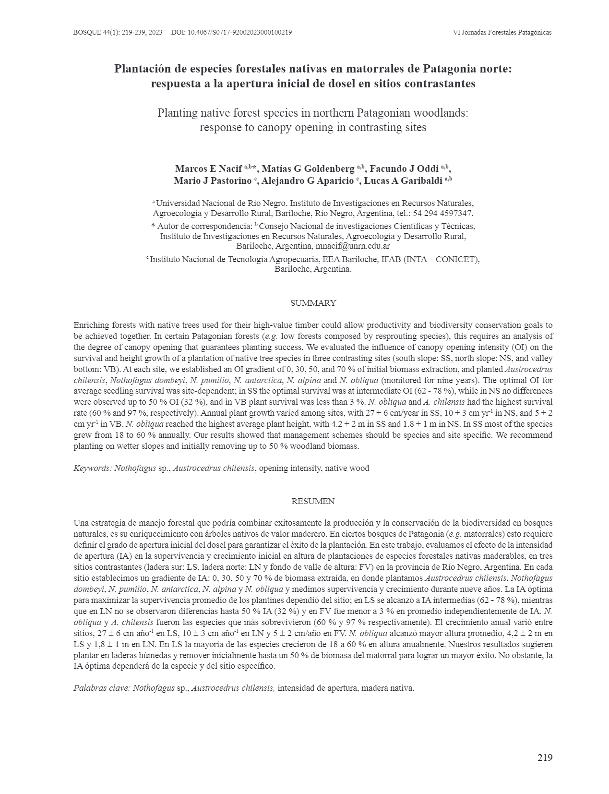Artículo
Una estrategia de manejo forestal que podría combinar exitosamente la producción y la conservación de la biodiversidad en bosques naturales, es su enriquecimiento con árboles nativos de valor maderero. En ciertos bosques de Patagonia (e.g. matorrales) esto requiere definir el grado de apertura inicial del dosel para garantizar el éxito de la plantación. En este trabajo, evaluamos el efecto de la intensidad de apertura (IA) en la supervivencia y crecimiento inicial en altura de plantaciones de especies forestales nativas maderables, en tres sitios contrastantes (ladera sur: LS, ladera norte: LN y fondo de valle de altura: FV) en la provincia de Río Negro, Argentina. En cada sitio establecimos un gradiente de IA: 0, 30, 50 y 70 % de biomasa extraída, en donde plantamos Austrocedrus chilensis, Nothofagus dombeyi, N. pumilio, N. antarctica, N. alpina y N. obliqua y medimos supervivencia y crecimiento durante nueve años. La IA óptima para maximizar la supervivencia promedio de los plantines dependió del sitio; en LS se alcanzó a IA intermedias (62 - 78 %), mientras que en LN no se observaron diferencias hasta 50 % IA (32 %) y en FV fue menor a 3 % en promedio independientemente de IA. N. obliqua y A. chilensis fueron las especies que más sobrevivieron (60 % y 97 % respectivamente). El crecimiento anual varió entre sitios, 27 ± 6 cm año-1 en LS, 10 ± 3 cm año-1 en LN y 5 ± 2 cm/año en FV. N. obliqua alcanzó mayor altura promedio, 4,2 ± 2 m en LS y 1,8 ± 1 m en LN. En LS la mayoría de las especies crecieron de 18 a 60 % en altura anualmente. Nuestros resultados sugieren plantar en laderas húmedas y remover inicialmente hasta un 50 % de biomasa del matorral para lograr un mayor éxito. No obstante, la IA óptima dependerá de la especie y del sitio específico. Enriching forests with native trees used for their high-value timber could allow productivity and biodiversity conservation goals to be achieved together. In certain Patagonian forests (e.g. low forests composed by resprouting species), this requires an analysis of the degree of canopy opening that guarantees planting success. We evaluated the influence of canopy opening intensity (OI) on the survival and height growth of a plantation of native tree species in three contrasting sites (south slope: SS, north slope: NS, and valley bottom: VB). At each site, we established an OI gradient of 0, 30, 50, and 70 % of initial biomass extraction, and planted Austrocedrus chilensis, Nothofagus dombeyi, N. pumilio, N. antarctica, N. alpina and N. obliqua (monitored for nine years). The optimal OI for average seedling survival was site-dependent; in SS the optimal survival was at intermediate OI (62-78 %), while in NS no differences were observed up to 50 % OI (32 %), and in VB plant survival was less than 3 %. N. obliqua and A. chilensis had the highest survival rate (60 % and 97 %, respectively). Annual plant growth varied among sites, with 27 ± 6 cm/year in SS, 10 ± 3 cm yr-1 in NS, and 5 ± 2 cm yr-1 in VB. N. obliqua reached the highest average plant height, with 4.2 ± 2 m in SS and 1.8 ± 1 m in NS. In SS most of the species grew from 18 to 60 % annually. Our results showed that management schemes should be species and site specific. We recommend planting on wetter slopes and initially removing up to 50 % woodland biomass.
Plantación de especies forestales nativas en matorrales de Patagonia norte: respuesta a la apertura inicial de dosel en sitios contrastantes
Título:
Planting native forest species in northern Patagonian shrublands: response to opening of forest canopy in contrasting sites
Nacif, Marcos Ezequiel ; Goldenberg, Matías Guillermo
; Goldenberg, Matías Guillermo ; Oddi, Facundo José
; Oddi, Facundo José ; Pastorino, Mario Juan
; Pastorino, Mario Juan ; Aparicio, Alejandro; Garibaldi, Lucas Alejandro
; Aparicio, Alejandro; Garibaldi, Lucas Alejandro
 ; Goldenberg, Matías Guillermo
; Goldenberg, Matías Guillermo ; Oddi, Facundo José
; Oddi, Facundo José ; Pastorino, Mario Juan
; Pastorino, Mario Juan ; Aparicio, Alejandro; Garibaldi, Lucas Alejandro
; Aparicio, Alejandro; Garibaldi, Lucas Alejandro
Fecha de publicación:
04/2023
Editorial:
Universidad Austral de Chile
Revista:
Bosque (Valdivia)
ISSN:
0304-8799
e-ISSN:
0717-9200
Idioma:
Español
Tipo de recurso:
Artículo publicado
Clasificación temática:
Resumen
Palabras clave:
AUSTROCEDRUS CHILENSIS
,
NATIVE WOOD
,
NOTHOFAGUS SP
,
OPENING INTENSITY
Archivos asociados
Licencia
Identificadores
Colecciones
Articulos (IRNAD)
Articulos de INSTITUTO DE INVESTIGACIONES EN RECURSOS NATURALES, AGROECOLOGIA Y DESARROLLO RURAL
Articulos de INSTITUTO DE INVESTIGACIONES EN RECURSOS NATURALES, AGROECOLOGIA Y DESARROLLO RURAL
Citación
Nacif, Marcos Ezequiel; Goldenberg, Matías Guillermo; Oddi, Facundo José; Pastorino, Mario Juan; Aparicio, Alejandro; et al.; Plantación de especies forestales nativas en matorrales de Patagonia norte: respuesta a la apertura inicial de dosel en sitios contrastantes; Universidad Austral de Chile; Bosque (Valdivia); 44; 1; 4-2023; 219-239
Compartir
Altmétricas



